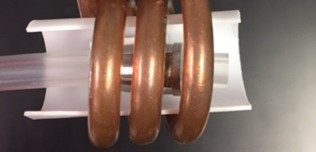Induction Brazing an Aluminum Assembly
Objective A company wanted to assess using induction heating for their aluminum assembly brazing process, and contacted THE LAB at Ambrell to utilize...
Applications
Applications: More
Applications: More

Industries:
Industries: More
Industries: More
Industries: More

Products:
Products: More
Services:
Services: More

Learn:
Learn: More
About:


Bonding involves connecting metal or materials containing metal to materials such as plastic, rubber or thermoplastic materials without using a bonding adhesive. Bonding with induction entails accelerating the polymerization of an adhesive by heating the metal parts to be joined. The required temperature range is generally from 150 ºC to 220 °C. Accurate heat control is critical to successfully bonding with induction heating.
Induction heating offers several benefits over competitive processes like spot welding including:
Rapid heating reduces process times
Easy integration for in-line and cell assembly operations
Financial savings from reduced energy consumption
Improved joint quality from controlled heating
Improved quality from non-contact heating
Induction bonding is used in an array of industries including:
Aerospace: carbon fiber/composite bonding
Automotive: magnets in electric motors, bonding of body parts like fenders, rear view mirrors, and various joints
Medical: metal-to-plastic bonding with dental tools
Optics: Many glass-to-metal bonding applications
Ambrell offers complimentary applications testing from THE LAB. We'd be happy to review your application and deliver a tailored system recommendation based on your process requirements. 

Objective A company wanted to assess using induction heating for their aluminum assembly brazing process, and contacted THE LAB at Ambrell to utilize...

Induction heating is a process that uses electromagnetic fields to heat electrically conductive materials. It has been used in numerous industries...

Induction heating, a process that uses electromagnetic induction to heat electrically conductive materials, is often thought of for large industrial...